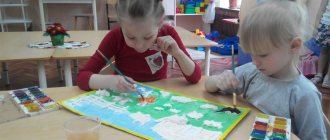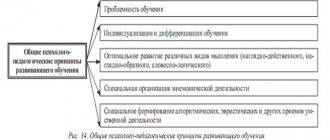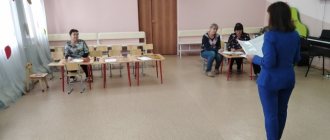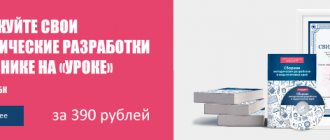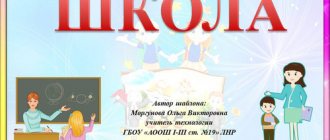The quality and effectiveness of preschool education are mediated by many factors, among which the educational program is not the least important. Since modern preschool educational institutions are represented by diversity, and parents have the opportunity to make a choice among kindergartens of various specializations and directions, the main preschool education programs are also quite diverse.
The Law “On Education” of the Russian Federation states that the staff of a preschool educational institution has the right to independently develop or select from existing programs those that most fully comply with the conditions and operating principles of a given preschool institution. It cannot be said that this or that program is better or worse - they are all designed taking into account the necessary requirements, and each of them has its own advantages.
Let’s briefly consider the main preschool education programs common in kindergartens in the Russian Federation.
What are the main preschool education programs?
All main preschool education programs can be divided into two types - comprehensive (or general education) and so-called partial (specialized, basic preschool education programs with a narrower and more pronounced focus).
Basic comprehensive preschool education programs take into account a holistic approach to the harmonious and comprehensive development of the child. According to such programs, education, training and development occur in all directions in accordance with existing psychological and pedagogical standards.
Partial basic preschool education programs imply a main emphasis on any one area in the development and upbringing of a child. In this case, a comprehensive approach to the implementation of preschool education is ensured by the competent selection of several partial programs.
Variability of preschool education as a condition for the high-quality implementation of the Federal State Educational Standard for Preschool Education
The topic of my speech is “Variability of preschool education as a condition for the high-quality implementation of the Federal State Educational Standard for Preschool Education.”
I will try to expand on the topic using this plan:
- What is variability
- What is educational diversity?
- What is variability in preschool education? (slide 1)
The third question will require more detailed disclosure, since the variability of preschool education is a condition for the high-quality implementation of the Federal State Educational Standard.
So what is variability ? In the modern lexicon, the word “variability” is found very often and is familiar to many. The word came to us from the Latin language and translated means “variability” and “different ” (slide 2).
And the variability of education is (slide 3 ):
Having found out what variability is and what is variability in education, we move on to revealing the concept of “variability of preschool education? (slide 4).
What are variable forms of preschool education? (slide 5).
In our preschool educational institution, such a variable form is the adaptation club “Rastishka ” (slide 6).
- And the variable content of educational programs is: a program that does not adapt the child to itself, but comes from the child
- a program focused on the individual characteristics of each preschooler,
- program for taking into account the principle of increasing independence of the child from adults in the process of activity
On (slides 7 and 7a) the programs that are used in the work of teachers of our preschool educational institution are indicated
And in order to realize the variability of preschool education, it is necessary to improve facilities to improve the quality of education in the context of the implementation of the Federal State Educational Standard for Education in preschool educational institutions (slide 8).
And this is how one of the objects for improving the quality of education is being implemented in our preschool educational institution in the context of the implementation of the Federal State Educational Standard for Preschool Education (slides 9, 10) . In their work, educators use modern information technologies (computer, interactive whiteboard, tablet, etc.) (slide 11
What are the positive benefits of using information technology in a teacher’s work (slide 12).
All this became possible thanks to the introduction into the work of preschool educational institutions of the “FEDERAL STATE EDUCATIONAL STANDARD OF PRESCHOOL EDUCATION”, which has become a real tool for developing and improving the quality of preschool education and its variability (slide 13).
Author: Victoria Viktorovna Tulupova Position: teacher of the 1st qualification category Place of work: MBDOU kindergarten No. 16 “Lastochka” Location: Kotovsk, Tambov region
Comprehensive core preschool education programs
“Origins” is a program in which due attention is paid to the development of a child’s personality in accordance with his age. The authors offer 7 basic personal characteristics that must be developed in a preschooler. The “Origins” educational program, like other basic preschool education programs, takes into account the comprehensive and harmonious development of the preschooler and makes it its priority.
“Rainbow” - in this program you will find 7 main types of activities typical for a preschooler. They include play, construction, mathematics, physical education, visual arts and manual labor, musical and plastic arts, speech development and familiarity with the outside world. Development under the program occurs in all of the above areas.
“Childhood” - the program is divided into 4 main blocks, each of which is a central element in the construction of preschool education. There are sections “Cognition”, “Healthy lifestyle”, “Creation”, “Humane attitude”.
“Development” is a special preschool education program, which is based on the principle of gradually increasing the complexity of educational, educational and educational tasks. The program provides a planned, consistent approach to preschool education and child development.
“Krokha” is a comprehensive program created specifically for children under 3 years of age. It takes into account the specifics of early childhood and ensures maximum efficiency in solving educational problems specifically for children of this age category. Includes several blocks - “We are waiting for you, baby!”, “Myself”, “Gulenka”, “How I will grow and develop”.
List of variative preschool education programs with brief annotations
List of variative preschool education programs with brief annotations
“Harmony of Development” (D. I. Vorobyova);
The main idea of the program involves:
- comprehensive, harmonious development of a child 2-7 years old;
-preservation and strengthening of physical and mental health;
-equal development of the intellectual, emotional and moral-volitional spheres of the individual;
-creating the necessary conditions for the full development of the creative potential of the child and teacher.
The program allows you to solve problems:
-knowledge of the world and oneself in it through the discovery of properties (phenomena), qualities, attributes of objects and experimentation with them;
-development of the ability to empathize, sympathize, communicate with living and inanimate objects;
-perception, thinking, memory, imagination, fantasy, the ability to purposefully engage in the creative process.
The program content is divided into five blocks.
1. Real objects of the world (living and inanimate nature, humans, animals, plants, buildings, transport).
2. Second nature (artistic images - painting, graphics, sculpture, architecture, decorative and applied arts).
3. Sound art (music, poetry, prose, folklore).
4. Sports-motor, plastic and theatrical-game activities (pantomime, sports and didactic games, dramatization).
5. Actually productive visual activity (drawing, appliqué, modeling, design).
“Kindergarten is a house of joy” (N. M. Krylova),
The objectives of the program are: caring for the health of the child and promoting the enrichment of the mental and physical development of each child; facilitating the child’s mastery of various types of activities at the level of independence and the development of his creative potential; assistance in mastering the basics of spiritual culture.
Structural and content characteristics
The authors prefer to call “Kindergarten - a home of joy” not a program, but a scientific and methodological system. In the traditional sense, the program is included in this system only as one part. The second part is “Technology”, a detailed project for introducing the program into practice. The third is what we call innovation, the conditions that need to be provided for educators to master technology.
Features of organizing the work of pre-school specialists
The authors of the “Kindergarten – House of Joy” program believe that the most difficult thing for a teacher is to establish trusting contacts with a child. Technology (drama, original work, etc.) frees up time and opens up the opportunity for creativity with children, allows you to look for your unique style of professional activity, your own style of interpreting the proposed events.
The metaphor “Ladder of Success” denotes the activities of a teacher that contribute to the enrichment of a child’s development. The four steps of the ladder correspond to the four levels of mastery of activity (recognition, reproduction under guidance, independence, creativity).
Educational and methodological support
In the “Kindergarten - House of Joy” program, the idea was realized to provide the teacher with detailed auxiliary material. The technology is described in 34 books and includes not only daily, but also hourly, and even minute-by-minute organization of the entire life and activity of a whole same-age group of 20-25 children during a 10-12-hour work schedule.
“Childhood” (V. I. Loginova, T. I. Babaeva, etc.);
Goal: ensuring the development of the child during preschool childhood: intellectual, physical, emotional, moral, volitional, social and personal. The introduction of a child into the world around him is carried out through his interaction with various spheres of existence (the world of people, nature, etc.) and culture (fine arts, music, children's literature and native language, mathematics, etc.). The program presents works of oral folk art, folk games, music and dance, and decorative and applied arts of Russia. The teacher is given the right to independently determine the schedule of classes, content, method of organization and place in the daily routine. The program highlights a new important section: “The child’s attitude towards himself” (self-knowledge). “Childhood” is a comprehensive educational program developed by the authors from the standpoint of humanistic pedagogy, a personal-activity approach to the development and upbringing of a preschool child. It includes three parts in accordance with the three stages of the preschool period (junior, middle, senior preschool age). Each part is based on general ideas that reflect the authors’ views on preschool childhood, its importance in human life, and the conditions for effective development in the preschool years. The intellectual, physical, emotional, moral, volitional, social and personal development of the preschooler takes place in the activities that are closest and most natural to the child. The entire content of the program is conventionally united around four main blocks: “Cognition”, “Humanite attitude”, “Creation”, “Healthy lifestyle”. For example, the “Humane attitude” block orients children towards a friendly, careful, caring attitude towards the world; The purpose of the “Cognition” block is to help preschoolers master a variety of accessible ways of understanding the world around them (comparison, elementary analysis, generalization, etc.). Particular emphasis in the program is placed on introducing children to the natural world and instilling a caring attitude towards natural objects. The program has a complete set of methodological support.
“Golden Key” (G. G. Kravtsov and others);
The “Golden Key” program is a comprehensive development program for children from 3 to 10 years old, developed by G. G. Kravtsov, E. E. Kravtsova, E. L. Berezhkovskaya and others. The goal of P. is to achieve an organic unity of conditions that provide children with the most complete , age-appropriate development, emotional well-being. P. is a model of lifelong education for children, which provides for groups of different ages (2-4 years, 5-7 years, 8-10 years), the predominance of individual forms of work with children, the formation of a system of relationships based on the type of family relationships, and an emphasis on the development of play activity and emotional-volitional sphere of preschool children.
“Origins” (edited by L. E. Kurneshova),
Program "Origins". This program holistically defines the content and nature of the modern pedagogical process, aimed at developing the basis of the personal culture of a preschool child. It implements the most important principle of humanistic pedagogy - dialogue between an adult and a child, children among themselves, teachers with each other, and a teacher with parents. The “Origins” program reflects the enduring importance of preschool childhood as an extremely important, basic period for subsequent human development. The basis of the program is the concept of psychological age as a stage of child development, which has its own structure and dynamics, as well as the scientific position of A.V. Zaporozhets on the amplification (enrichment) of child development, the relationship of all its aspects.
The main goal of the program is the formation of a well-rounded personality from birth to 7 years of age, its universal, including creative, abilities to a level corresponding to the age capabilities of the child; ensuring every child has an equal start in development; maintaining and promoting health.
In accordance with this approach, the program identifies the following age stages: early childhood - infancy (up to one year); early age (from one year to three years); preschool childhood: junior preschool age (from three to five years) and senior (from five to seven years). This age periodization, according to the authors, allows us to see both the most general trends and the individual development perspective of each child.
The program is built in accordance with the didactic principles of education, training and development of preschool children. For each age stage, the program identifies four leading lines of development: social, cognitive, aesthetic and physical; the features of the development of these lines in infancy, early, junior and senior preschool age are revealed; a hierarchy of main types of activity is set (communication, objective activity, game). The program gives a special place to play activity as the main one in the development of the personality of a preschool child. The game permeates all structural components of the program and its content as a whole.
The program contains new, independent sections: “Health”, “Speech and speech development”, “The world in which we live”, “Nature and the child”, “Culture of everyday life” and others, which significantly complement and enrich it.
“Little thing” (G. G. Grigorieva, E. G. Kravtsova, etc.);
The goal of the program is the comprehensive development, education and training of children under three years of age.
A program has been developed in the spirit of the ideas of humanizing family and public education of young children. The program provides a multi-level, individually differentiated approach to the child.
Child upbringing and development programs are presented in dialectical unity and interconnection. At the same time, the indicative nature of their content and the need to take into account the individual pace, level and direction of the child’s development are emphasized.
The program is built on the principles of a systematic and activity-based approach, and is presented in four blocks: prenatal pedagogy; characteristics of the physical and mental development of a child from birth to three years; development and education of children in the first year of life; development and upbringing of a child in the second and third year of life.
The program contains information materials on all areas of personality development of a child under three years of age, as well as methodological recommendations. It includes a selection of textbook materials (literary works) for reading and telling them to children, multifunctional reference materials and a list of methodological literature. The appendices provide tables of development levels and achievements of children in each age period, as well as literary material and approximate scenarios for family holidays.
“Fundamentals of the safety of preschool children” (Authors: R. B. Sterkina, O. L. Knyazeva, N. N. Avdeeva).
Goal: to develop the child’s skills of adequate behavior in various unexpected situations, independence and responsibility for their behavior. The program involves solving the most important social and pedagogical problem - developing in a child the skills of adequate behavior in various unexpected situations.
The content includes six sections: “Child and other people”, “Child and nature”, “Child at home”, “Child’s health”, “Child’s emotional well-being”, “Child on the city streets”. When implementing this program, each preschool institution organizes education taking into account the individual and age characteristics of children, sociocultural differences, and the uniqueness of home and living conditions in urban and rural areas. The program has an educational and methodological set: a textbook on the basics of life safety for children of senior preschool age and four colorfully illustrated handout albums for children.
“Development” (edited by O. M. Dyachenko).
The program was based on the idea of A.V. Zaporozhets about the intrinsic value of the preschool period of development and L.A. Wenger’s concept of the development of abilities.
The program requires the establishment of a person-centered model of education and training. The program is compiled for each age and contains an explanatory note and a detailed description of working with children.
Goals: development of children's mental and artistic abilities, as well as the development of specific preschool activities.
The methods of preschool education have been radically changed - children are given a system of successively more complex tasks. The main emphasis of the program is not on what factual material is given to children, but on how it is given. When developing program material, we first took into account what means of solving cognitive and creative problems should be learned by children, and on what content these means can be learned most effectively.
In the younger group, the main means are sensory standards (the so-called “impact” section - the development of sensory culture); in the middle - visual models of spatial relationships such as a plan or drawing (formation of spatial relationships); in older preschool age, the central place is occupied by conditionally symbolic visual models reflecting quantitative relationships, relationships of sounds in a word, the relationship of natural phenomena, the relationship between the content and scope of concepts (mathematics, literacy, ecology, logic).
In the structure of the educational process organized under the Development program:
1. Development of sensory abilities (younger age).
2. Speech development and familiarization with fiction.
3. Introduction to literacy (junior, middle groups); preparation for literacy training (from the senior group).
4. Formation of ideas about the surrounding world about oneself (younger age).
5. Familiarization with nature (middle group).
6. Formation of elementary environmental ideas.
7. Development of elements of logical thinking (from the senior group).
8. Formation of elementary mathematical concepts (from the middle group).
9. Familiarization with spatial relationships (from the middle group).
10. Constructive activity.
11. Visual activity.
12. Game activity.
General requirements for educational programs
In accordance with the recommendations for the development of educational programs, they should be developed on the basis of the principle of person-oriented interaction between the teacher and children (students, pupils). Each educational program should be aimed at developing children’s cognitive activity, communication skills, the abilities of each child, and the formation of creative imagination.
In addition, programs must provide:
- protecting and strengthening the mental and physical health of children;
- ensure the emotional well-being and development of every child;
- intellectual and creative development;
- familiarization with cultural and universal values;
- ensuring productive interaction with the child’s family.
In accordance with educational programs, the organization of children's activities is carried out in the following forms:
Finished works on a similar topic
- Course work Variable education program 480 rub.
- Abstract Variable education program 220 rub.
- Test Variable education program 230 rub.
Receive completed work or specialist advice on your educational project Find out the cost
- specially organized training sessions;
- free time;
- unregulated activities.
Note 1
When building a program, it is necessary to take into account the age characteristics and needs of children, the individuality of mental and physical development, as well as the capabilities of the educational organization (technical and methodological equipment, the availability of the necessary teaching staff, etc.).
Classification of modern educational programs:
- Alternative and variable.
- Basic, regional, federal and municipal.
- Basic and additional.
- Approximate.
- Partial and complex.
Variative educational programs are distinguished depending on the philosophical and conceptual basis, which includes the view of the program author on the child, the patterns of development of children at different age stages, and the creation of the necessary conditions aimed at the full formation and development of the individual.
Too lazy to read?
Ask a question to the experts and get an answer within 15 minutes!
Ask a Question
Content section Programs should include:a) a description of educational activities in accordance with the areas of child development presented in five educational areas , taking into account the used variable exemplary basic educational programs of preschool education and teaching aids that ensure the implementation of this content;
b) description of variable forms, methods, methods and means of implementing the Program, taking into account the age and individual characteristics of students, the specifics of their educational needs and interests;
c) a description of educational activities for the professional correction of developmental disorders of children , if this work is provided for by the Program.
The content section of the Program should present:
a) features of educational activities of different types and cultural practices;
b) ways and directions of supporting children's initiatives ;
c) features of interaction between the teaching staff and the families of students;
d) other characteristics of the content of the Program, the most significant from the point of view of the authors of the Program.
The part of the Program formed by participants in educational relations may include various areas chosen by participants in educational relations from among partial and other programs and/or created by them independently.
This part of the Program should take into account the educational needs, interests and motives of children, their family members and teachers and, in particular, can be focused on:
– the specifics of national, sociocultural and other conditions in which educational activities are carried out;
– selection of those partial educational programs and forms of organizing work with children that best suit the needs and interests of children, as well as the capabilities of the teaching staff;
– established traditions of the Organization or Group.
The content of correctional work and/or inclusive education is included in the Program if it is planned to be mastered by children with disabilities.
This section must contain special conditions for obtaining education by children with disabilities, including mechanisms for adapting the Program for these children, the use of special educational programs and methods , special teaching aids and teaching materials, conducting group and individual correctional classes and providing qualified correction of disorders their development.
Corrective work and/or inclusive education should be aimed at:
1) ensuring the correction of developmental disorders of various categories of children with disabilities, providing them with qualified assistance in mastering the Program;
2) development of the Program by children with disabilities, their diversified development, taking into account age and individual characteristics and special educational needs, social adaptation.
Correctional work and/or inclusive education of children with disabilities who are mastering the Program in Combined and Compensatory Groups (including for children with complex disabilities) must take into account the developmental characteristics and specific educational needs of each category of children.
In the case of organizing inclusive education for reasons not related to children’s health limitations, highlighting this section is not mandatory; if it is separated, the content of this section is determined by the Organization independently
Variable forms of accessible quality education in the context of the Federal State Educational Standard
In recent years, significant attention has been paid to preschool education at the state level. This is evidenced by the adopted laws, regulations at the federal and regional levels, instructions of the President of the Russian Federation and the Government on issues of preschool education. The results should be: ensuring territorial accessibility of quality preschool education; reducing the priority when placing children in preschool institutions.
It is known that the foundations of personality are laid in preschool age and, to a large extent, its effectiveness predetermines the success and life strategy of an adult. From childhood, a child takes away something that is then retained for the rest of his life, therefore the development of preschool education, support and accompaniment of the family is today considered as an indicator of the development of a given society.
Modern society places new demands on the education system of the younger generation, including its first stage – the preschool education system.
In recent years, significant attention has been paid to preschool education at the state level. This is evidenced by the adopted laws, regulations at the federal and regional levels, instructions of the President of the Russian Federation and the Government on issues of preschool education. The results should be: ensuring territorial accessibility of quality preschool education; reducing the priority when placing children in preschool institutions.
It is known that the foundations of personality are laid in preschool age and, to a large extent, its effectiveness predetermines the success and life strategy of an adult. From childhood, a child takes away something that is then retained for the rest of his life, therefore the development of preschool education, support and accompaniment of the family is today considered as an indicator of the development of a given society. The prospects for the development of preschool education are determined by increasing the accessibility and ensuring the quality of preschool education in Russia, including the freeness of the educational process for all children. This is understood as the opportunity to choose and enroll in a preschool educational institution chosen by parents and continuous education there.
After the adoption of the law on education, which allowed the use of variable preschool education programs, it became more interesting for teachers to work, and parents had the opportunity to choose kindergartens with certain programs that correspond to the interests of their children.
An analysis of currently existing preschool education programs, updated and newly created, showed their great diversity and variable content (subject to compliance with the requirements of the Standard):
From birth to school: an exemplary general educational program for preschool education / Ed. NOT. Veraksy, T.S. Komarova, M.A. Vasilyeva. – M.: MOSAIKA-SYNTHESIS, 2014. – 333 p.
Approximate basic educational program for preschool education “Kindergarten according to the Montessori system” / Ed. E.A. Hiltunen; [O.F. Borisova, V.V. Mikhailova, E.A. Hiltunen]. – M.: Publishing House “National Education”, 2014. – 186 p.
Approximate basic educational program for preschool education “Paths” / ed. V.T. Kudryavtseva. – M.: Ventana-Graf, 2014. – 170 p.
The main GOALS of the federal state educational standard for preschool education ARE:
• ensuring by the state equal opportunities for every child to receive quality preschool education;
• ensuring state guarantees of the level and quality of education based on the unity of mandatory requirements for the conditions for the implementation of basic educational programs, their structure and results of development;
• maintaining the unity of the educational space of the Russian Federation regarding the level of preschool education.
It is the standard as a normative legal document that is designed to ensure that every child, regardless of national, territorial, property and other differences, has the opportunity to achieve the necessary and sufficient level of development for subsequent successful education at the next level of the Russian lifelong education system.
The goal of variable forms of preschool education is to realize the right of every child to quality and accessible education and provides for different modes of stay for children, both with normal development and with disabilities and special educational needs
Today we are convinced that the classic form of preschool education - full-day kindergarten - has been replaced by new variable forms. Therefore, the problem of providing preschoolers with places in kindergartens is partially solved by turning to such variable forms.
1.Family groups - a form of organizing preschool education
, aimed at ensuring the comprehensive development of children who do not attend preschool educational institutions, supporting large families, providing parents with employment opportunities, and the practical implementation of an individual approach to raising a child.
The family group is organized in residential premises (private residential buildings or apartments) at the place of residence of the family. Family group workers are employees of the institution.
The following social effects of organizing family groups at preschool educational institutions can be noted:
1
. The issue of reducing the queue for kindergartens and implementing the constitutional right of citizens of the Russian Federation to receive public and free preschool education is being resolved.
2.
Parents can get an official job - they become educators, junior educators assigned to preschool educational institutions. Consequently, they have a work record and salary, depending on their qualifications.
3
. Family groups are a financial support for the family, since they will be allocated a certain amount to feed each child.
4.
The family group can be attended by children who, for various reasons, do not attend regular preschool institutions.
2.Short-term stay group - as one of the variable forms of preschool education
These groups are created for children of early and preschool age in order to ensure their comprehensive development and formation of the foundations of school education, providing advisory and methodological support to their parents (or legal representatives) in organizing the upbringing and education of the child, his social adaptation.
A shortened stay in a preschool educational institution and learning in the form of games make it possible to provide the most comfortable environment for the child, giving him the opportunity to gain his first positive experience in new social conditions, which solves many problems of a communicative nature. Daily opportunities to communicate with parents on issues of concern, as well as group consultations on a single topic, allow us to solve issues of adaptation, development and upbringing of children most effectively, in accordance with their age and psychological characteristics.
Short-term groups for frequently and long-term ill children, correctional orientation
tasks:
— ensuring access to preschool education for young children;
— providing pedagogical and psychological assistance to parents raising children at home; and children with developmental disabilities
- create favorable conditions for adaptation to the social world of young children, facilitate entry into a group of peers, and admission to kindergarten.
3.Organization of the work of the Advisory Point (CP) for parents.
Advisory point (CP) - for children aged 1 to 7 years raised in a family environment, created to ensure the unity and continuity of family and public education; providing psychological and pedagogical assistance to parents; support for the comprehensive development of the personality of children who do not attend educational institutions.
Main tasks of the CP:
*providing advisory assistance to parents on various issues of education, training and development of a preschool child;
*providing assistance in the socialization of preschool children
*Parents have the opportunity to contact specialists at any time and receive the necessary advice
4. Private kindergartens
Thus, the variability of education is one of the fundamental principles and direction of development of the modern education system in Russia, which makes it possible now to cover traditionally “unattainable” categories of preschoolers with preschool education services and to offer them a wide range of services before school.
Variable educational process is the interconnected activity of all participants in the educational process to realize the goals of education, carried out in conditions of choice of content (within the framework of state standards), means and methods of activity and communication, the value-semantic attitude of the individual to the goals, content and process of education.
An analysis of the current situation in the education system regarding the issue raised shows that at the moment the growth in the waiting list for preschool institutions has decreased, and parental interest in these institutions has increased.
Expected results
from the introduction of variable forms of education in preschool institutions:
*improving the quality and accessibility of preschool education for children from different social groups and segments of the population, regardless of the place of residence and income of the parents;
*a cultural image of preschool childhood will emerge as the main resource for the development of all spheres of a child’s life and his future,
*content, modern technologies and models of innovative educational infrastructure will ensure the full personal development of the child and optimize the continuity of preschool and primary general education.
MUNICIPAL AUTONOMOUS PRE-SCHOOL EDUCATIONAL INSTITUTION
KINDERGARTEN No. 34 “TEREMOK”, BALAKOVO, SARATOV REGION
Variable forms of accessible quality education in the context of the Federal State Educational Standard
Educator: Belyaeva Maria Alexandrovna
Modern educational programs for preschool institutions
According to recommendations for the examination of preschool educational institutions, programs should be built on the principle of person-centered interaction between adults and children. Should be aimed at developing curiosity as the basis of cognitive activity in a preschooler; development of the child’s abilities; formation of creative imagination; development of communication. Programs must ensure the protection and strengthening of the physical and mental health of children, their physical development; the emotional well-being of each child; intellectual development of the child; creating conditions for the development of the child’s personality and creative abilities; introducing children to universal human values; interaction with the family to ensure the full development of the child. Programs should provide for the organization of children's life in three forms: classes as a specially organized form of education; unregulated activities; free time provided for a child in kindergarten during the day. Programs should be built taking into account types of activities specific to preschool children (games, construction, visual, musical, theatrical activities, etc.); Programs should provide for the possibility of implementing individual and differentiated approaches to working with children. Modern programs are classified into variable and alternative; basic, federal, regional, municipal; basic and additional; approximate; complex and partial programs. Variative and alternative programs differ in philosophical and conceptual foundations (the authors’ views on the child, on the patterns of his development, and, consequently, on the creation of conditions that contribute to the development of personality). Variable programs can be basic and additional. Basic programs. The content of the main program meets the requirements of complexity, i.e. it includes all the main directions of development of the child’s personality: physical, cognitive-speech, social-personal, artistic and aesthetic, and contributes to the formation of the child’s versatile abilities (mental, communicative, regulatory, motor, creative) , the formation of specific types of children's activities (subject, play, theatrical, visual, musical, design, etc.). Thus, the main program determines the entire range of general developmental (including correctional) tasks and all substantive aspects of the educational activities of preschool educational institutions within the framework of the implementation of basic educational services. Among the main ones, a special place is occupied by correctional programs (in areas of correction), the implementation of which involves introducing a set of necessary changes in the organization of children’s lives, adjusting exemplary regimes and creating a special subject-development environment for preschool educational institutions. Additional preschool education programs. Based on clause 6 of Art. 14 of the Law of the Russian Federation “On Education”, an educational institution, in accordance with its statutory goals and objectives, can, along with the main ones, implement additional educational programs and provide additional educational services beyond the limits of the main educational programs that determine its status. The provision of additional educational services (paid, free) and the implementation of additional educational programs is carried out only at the request of parents (their legal representatives) on a contractual basis with them. Additional educational programs include educational programs of various orientations: artistic and aesthetic cycle, ethnocultural, cultural, intellectual and developmental, communicative and speech, environmental, physical education and health, various correctional orientations, etc. In some cases, partial preschool education programs can be used as additional ones. Additional educational programs cannot be implemented in place of or within the framework of the main educational activities at the expense of the time allocated for the implementation of the main educational programs of preschool education (walks, naps, main classes, games). The number and duration of classes conducted as part of the provision of additional educational services are regulated by SanPiN 2.4.1.1249-03, and the total time of classes in basic and additional programs should not significantly exceed the permissible volume of the weekly load, taking into account the age of the children. When developing original (variable) programs based on exemplary ones, it is possible to both expand the scope of their content and more in-depth presentation of individual topics (blocks) included in the exemplary program, which makes it possible to put into practice the principle of variability in preschool education.
Development of variable forms of preschool education
child care and supervision in the evening, on weekends and holidays.
classes with a teacher-psychologist
classes with a speech therapist
classes with a speech pathologist
lessons with a music director
An evening group at an educational institution is a form of organization of preschool children, aimed at assisting parents in matters of raising and educating children, as well as supervising and caring for children [4].
Weekend group for preschool children who do not attend a preschool educational institution during the working week - a form of organization of preschool children on weekends of the year, aimed at the supervision, care, education and health improvement of preschool children who do not attend a preschool educational institution during the working week . A similar form of provision of preschool education services can be organized on the basis of state, municipal and non-state educational institutions and institutions of additional education [26].
The tasks of weekend groups can be:
assistance to parents in the supervision and care of children of early and preschool age;
children’s acquisition of age-appropriate basic knowledge;
social and moral education of children.
The development of variable forms of education is ultimately aimed at ensuring the highest possible degree of individualization of education.
Thus, we can conclude that the modern system of domestic preschool education does not stand still; it is built on the principles of dynamism, flexible response to the needs of society and the individual, and is characterized by the emergence of new types of educational institutions for children and a variety of educational services.
Thus, the organization of new, economically feasible forms of preschool education is not only possible, but also a promising way to preserve and develop the preschool network. This will save budget funds, reduce parental fees and at the same time make preschool education services more accessible to the population.
The variability of forms of education and upbringing will help increase the number of children who will be able to receive a quality education at preschool educational institutions, which is essential for building continuity between preschool and primary general education. New forms of education and upbringing of children should in no way be considered as an alternative to existing ones. A significant part of parents are satisfied with the preschool operating hours full-time and around the clock. It is fundamentally important that even with a reduction in the time children spend in preschool educational institutions, their development in all main areas (cognitive, artistic-aesthetic, social-emotional, physical) must be ensured in accordance with the state standard of preschool education. The main trend that can be clearly observed is that preschool education has increased its status throughout the world and has become the subject of national policies. The Russian preschool education system is recognized by the international community as one of the most effective early childhood education systems.
